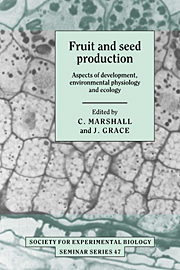Book contents
- Frontmatter
- Contents
- Contributors
- Preface
- Plant reproductive biology: an overview
- The environmental control of reproductive development
- Pollination and fertilization in higher plants
- Embryogenesis
- Environmental and internal regulation of fruiting, with particular reference to Cox's Orange Pippin apple
- Fruit growth and sink strength
- Control of grain growth and development
- The regulation of maternal investment in plants
- Ecological and physiological aspects of reproductive allocation
- Are the distributions of species determined by failure to set seed?
- Edible fruits in a cool climate: the evolution and ecology of endozoochory in the European flora
- Index
Fruit growth and sink strength
Published online by Cambridge University Press: 04 August 2010
- Frontmatter
- Contents
- Contributors
- Preface
- Plant reproductive biology: an overview
- The environmental control of reproductive development
- Pollination and fertilization in higher plants
- Embryogenesis
- Environmental and internal regulation of fruiting, with particular reference to Cox's Orange Pippin apple
- Fruit growth and sink strength
- Control of grain growth and development
- The regulation of maternal investment in plants
- Ecological and physiological aspects of reproductive allocation
- Are the distributions of species determined by failure to set seed?
- Edible fruits in a cool climate: the evolution and ecology of endozoochory in the European flora
- Index
Summary
Introduction
Fruit growth is part of the integrated growth of a plant. Therefore, fruit yield is determined by the interaction between growing conditions and morphological characters, as well as the physiological activities, of the whole plant.
It has long been recognized that the improvement of fruit yield is dependent on our understanding of the factors controlling both the production by the leaf (i.e. assimilate production) and the sink strength of the fruit (i.e. assimilate partitioning) (see Watson, 1968). Most likely, the key to understanding the regulation of fruit growth is to identify the responses to the environment by the morphological factors and metabolic processes inside the fruit interacting with those in the rest of the plant. In terms of assimilate partitioning, fruits are irreversible storage sinks, as the imported assimilate is either used for growth or stored as reserves and no net export occurs during the life of the organ (Ho, 1988). Therefore, it is essential to know how the supply, or the competition for the supply, of assimilate by the individual fruit is regulated. In this review, I examine fruit growth in terms of source-sink interaction, sink competition and sink strength determination. Evidence will be presented that, apart from the supply of assimilate, both cell number (i.e. sink size) and some of the physiological activities (i.e. sink activity) within a fruit may determine its sink strength in attracting assimilate to sustain fruit growth.
- Type
- Chapter
- Information
- Fruit and Seed ProductionAspects of Development, Environmental Physiology and Ecology, pp. 101 - 124Publisher: Cambridge University PressPrint publication year: 1992
- 32
- Cited by



